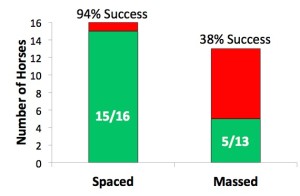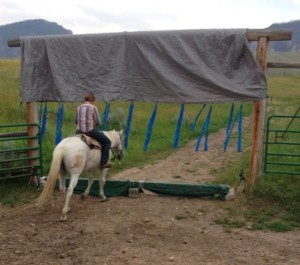At BestHorsePractices, we connect equine research with everyday interactions. We share the discoveries of good research and its implications with Regular Joe’s.
Follow Fred is a regular BHP feature. It concerns the work of one man with his feet firmly in both BHP camps: horsemanship and science.
Fred Holcomb, a recent graduate of Davidson College, has excelled at English and Western riding, including a lengthy stint at the Alvord Ranch with Martin Black and seminar work with Black and Dr. Steve Peters.
Read more Follow Fred articles.
By Maddy Butcher
While the rest of us were tossing hay and saddling up, Fred Holcomb was hunched over a computer, scrutinizing data and crunching numbers.
The 22-year old researcher was analyzing videotape from scores of timed training sessions executed last summer at the HF Bar Ranch in Saddlestring, Wyoming. Read more about the trials here.
Holcomb’s work is filling a sizeable gap in current research on how horses learn best. He’s looking at how recess time between training sessions affects learning. In other words: Should you give your horse a break, when it’s struggling to learn about crossing a tarp, opening a gate, or sidepassing?
The answer, according to Holcomb’s preliminary findings, is a resounding “YES!”
Holcomb presented a poster of his findings at the 22nd Annual International Conference on Comparative Cognition, held in Melbourne Beach, Florida this spring. It was “very well received,” said Holcomb, who graduated cum laude, with honors in Psychology, from Davidson College last month. (What’s a poster? Scroll down.)
The Value of Taking a Break
Remarkably, almost no academic research has been published in this area of equine cognition or learning behavior. Holcomb’s most relevant reference of comparable work came from a crude, some might say cruel, study involving ponies, small hurdles, and mild electrical shocks, in 1980. Read more here.
Needless to say, Holcomb’s work was undeniably more humane, more relevant, and more successful in terms of conclusive results. While the research project was displayed at an academic conference and may eventually be published in an academic journal, it can be put to immediate use with every horse owner in her backyard, arena, and on the trail.
“I feel Fred’s research can provide a terrific bridge between academia and horse training,” said his advisor, Dr. Kristi Multhaup. “He’s doing the work that can bridge our two communities. He’s contributing evidence-based research to potentially make training safer and more effective, while it’s also theoretically valuable to researchers.”
Why Fred’s work is special
Science is about observation and testing, sure. But it’s also about knowing your subjects intimately before you form a hypothesis, design a project, and start collecting data. As Dr. Frans de Waal noted here, researchers can’t ask good questions until they really, really know what they think they’re seeing. Researchers fail us when they don’t have those close encounters.
Or, as colt starter Mike Kevil told me, “Scientists may miss or ignore the small subtleties – things obvious to a horseman.”
Those things were obvious to Holcomb, too, because he readily swaps his board and mortar for a cowboy hat. The Virginia man has spent time with Martin Black at the Alvord Ranch, and for the past several summers has wrangled at Wyoming ranches. He also attended Evidence-Based Horsemanship seminars led by Dr. Steve Peters and Martin Black. Evidence-Based Horsemanship is a book and concept that balances equine neuroscience with horsemanship.
Here’s what Fred found
He directed a rider to ask HF Bar ranch horses to cross an obstacle (simultaneously stepping over a beam, passing under a tarp and passing through strips of tarp). In one group, the rider asked the horse to cross the obstacle for the entire allotted time (four minutes). In another group, the horses were given breaks after two minutes. In graph at right, the two groups are termed “massed” and “spaced,” respectively. Read more here.
This latter group was almost three times as successful in achieving the task. In other words, horses allowed to pause and rest were significantly more successful at learning to cross the obstacle.

At left, green block indicates the success rate of horses given time to dwell. At right, green indicates success rate of horses given no dwell time.
The months of video analysis and coding paid off with a conclusive result that echoes what the Dorrance brothers might have uttered years ago: “Colts are like third graders. They need recess.”
What’s Next
At the Comparative Cognition conference, Holcomb learned that many scientists focus first on their question and then search for a species that will best answer that specific question. The new graduate comes at his research from a completely different perspective: “I have a million questions about one species,” he said. “I have a passion for the horse. With horses, there’s so much opportunity for applied work compared to working with pigeons or rats.”
Graduate school is in the future. But first, he’s heading back to Wyoming for a season of wrangling and may head to farrier school at Montana State University this fall.
“My biggest fear is to be an animal behaviorist who doesn’t know how to deal with his own subjects,” he said. “There’s so much to learn by being on them.”
Academic-speak:
Presenting a poster at an academic conference is a bit like manning a trade show booth or info center desk. Explains Holcomb: “Posters are visual props used to briefly present research. I stood by my poster during the open poster fair, so that people could walk by and briefly read about the research and engage the presenter (me) to hear more about the project.”
Check out all the Follow Fred features here.



I am very proud of Fred. He is asking relevant questions and answering them with science and a life long knowledge of and interaction with horses. He is in a unique position to bridge science with enironmental validity (what works in real life). He is doing a great service to the horseworld.
Thank you both for all the science-based research on how to enhance a horse’s willingness to learn. There are many opinions in the horse world about this topic; however, until opinions are science-based, there is no validity to base behavior. We learned about science-based programs that were the most effective in preventing youth alcohol and drug abuse–other programs based on opinion were not funded. Congratulations for taking the time to do this valuable work–yes, a better world for horses (and people)!!
Thank you for sharing your work. I find that in addition to m I mental breaks, day & even multiple day breaks work well with breakthroughs or new concepts. I swear they sleep on it!